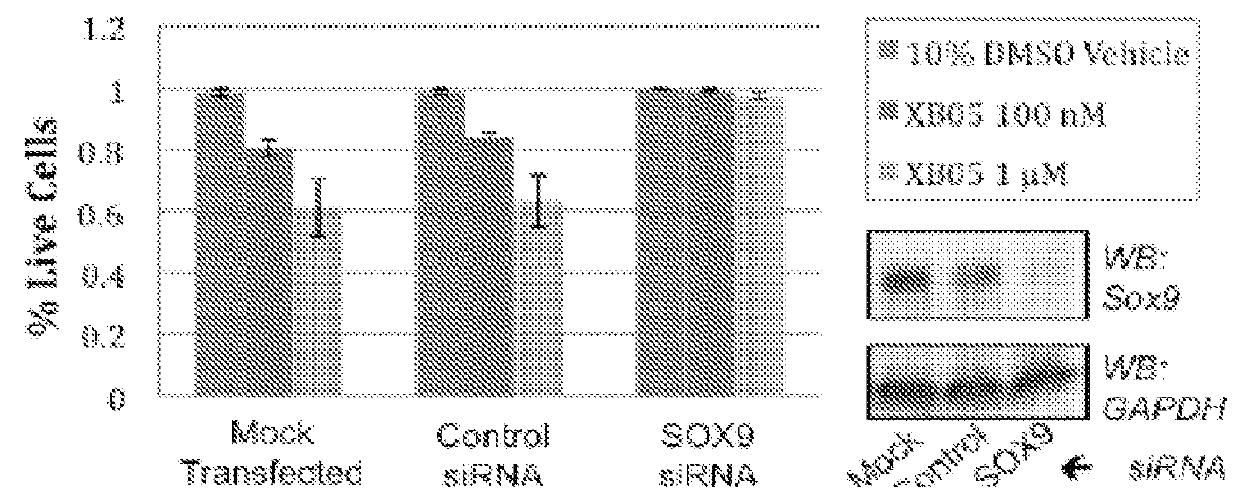Predictive marker of DNMT1 inhibitor therapeutic efficacy and methods of using the marker
a technology of dnmt1 inhibitor and predictive marker, which is applied in the field of predictive marker of dnmt1 inhibitor therapeutic efficacy and methods of using the marker, can solve the problems of treatment side effects, high cost of drug development, and difficult translation to safe and effective therapies
- Summary
- Abstract
- Description
- Claims
- Application Information
AI Technical Summary
Problems solved by technology
Method used
Image
Examples
example 1
Levels of SOX9 Expression Determine Response to XB05 (BX11)
[0183]A variety of different breast cancer cell lines were treated with 1 μM BX11, and the cytotoxic effect of 1 μM BX11 was determined. The cytotoxicity data for each breast cancer cell line was correlated with the SOX9 level present in each cell line prior to treatment.
[0184]In a second set of experiments, HOP92 cells were transfected for 24 hours with 60 nM siRNA against SOX9, control siRNA, or no RNA (mock). Knockdown of SOX9 was confirmed by Western blots (WB). Cells were then treated with XB05 (BX11) as indicated. After 48 hours, the cell number and viability for each sample was determined using an automated cell counter.
[0185]The relationship between between BX11 (XB05) activity and SOX9 expression was observed from NC160 data using COMPARE, which show a significant correlation (R=0.58 for 60 cell lines) between the LC50 values (concentration of BX11 (XB05) required for 50% cell death) and SOX9 mRNA expression, such t...
example 2
Anti-Proliferative Effects of XB05 (BX11)
[0187]FIG. 3A shows the results from the NCI 60 cell line screen which showed a good correlation between cell death induced by XB05 (BX11) (bars with black outline, indicating relative LC50 values) and expression of a gene referred to here as “Biomarker X” (red line, indicating mRNA levels). FIG. 3B are Western blots (WB) confirming expression of Biomarker X (SOX9) protein in the sensitive cell lines. Clonogenic survival assays (FIG. 3C)) and MTT proliferation assays (FIG. 3D) also suggest a correlation between XB05 (BX11) sensitivity and Biomarker X levels. Where indicated, HCT116 cells (colon cancer, sensitive to XB05 (BX11)) and LLC cells (murine lung carcinoma, resistant to XB05 (BX11)) are shown as positive and negative controls, respectively. (SOX9 levels were not assayed in LLC cells because they are of mouse origin).
example 3
Inhibitory Effects of BX11 on Breast Cancer Cells
[0188]BX11 (XB05) has potent antiproliferative and cytotoxic activity on a variety of breast cancer cell types, with some cell types having GI50 values less than or equal to 10 μM. There were several cell lines that seemed particularly sensitive to the cytotoxic effects of BX11 (BX05). For example, in the breast cancer panel, only MDA-MB-231 and MDA-MB-435 exhibited significant cell death following treatment with 1 μM BX11 (FIG. 4A). The MDA-MB-231 cell line is derived from a triple negative breast cancer (TNBC) and MDA-MB-435 was originally described as being derived from a TNBC, although its origin is now uncertain (it is unquestionably derived from the same source as the M14 melanoma cell line and many believe it is a melanoma, although some argue that both cell lines are derived from a breast carcinoma). Additional experiments have confirmed the inhibitory effects of BX11 (BX05) on MDA-MB-251 breast cancer cells in standard soft a...
PUM
| Property | Measurement | Unit |
|---|---|---|
| time | aaaaa | aaaaa |
| time | aaaaa | aaaaa |
| time | aaaaa | aaaaa |
Abstract
Description
Claims
Application Information
 Login to View More
Login to View More - R&D
- Intellectual Property
- Life Sciences
- Materials
- Tech Scout
- Unparalleled Data Quality
- Higher Quality Content
- 60% Fewer Hallucinations
Browse by: Latest US Patents, China's latest patents, Technical Efficacy Thesaurus, Application Domain, Technology Topic, Popular Technical Reports.
© 2025 PatSnap. All rights reserved.Legal|Privacy policy|Modern Slavery Act Transparency Statement|Sitemap|About US| Contact US: help@patsnap.com



